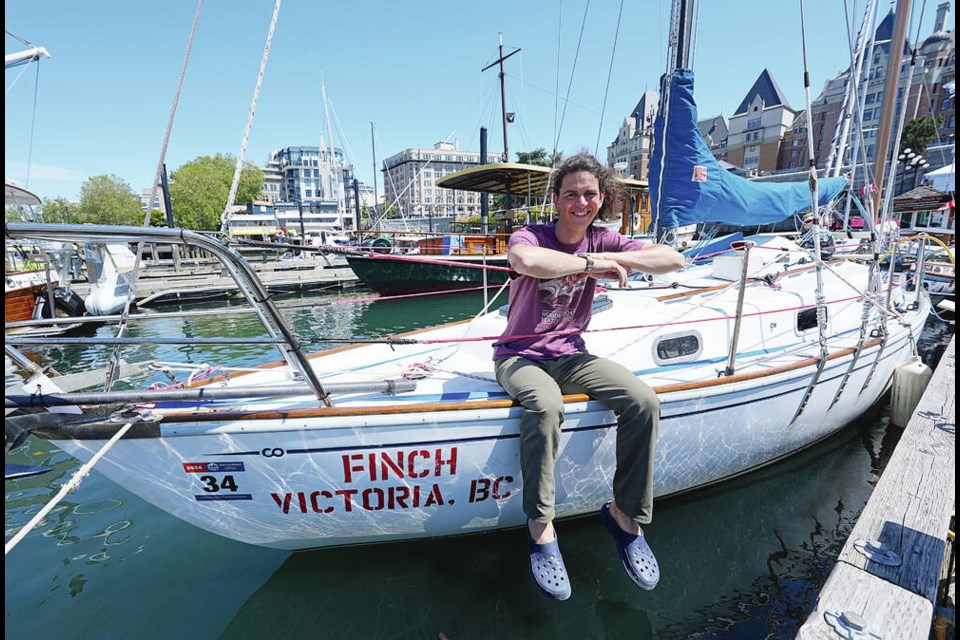Liam Pareis might only have $70 left to his name, but he’s ready to set off today on another 1,000 kilometres of sailing along the B.C. coast to Ketchikan, Alaska.
Pareis arrived in Victoria from Port Townsend, Washington, on Sunday after completing the qualifying leg for Race 2 Alaska, an endurance sailing event for non-motorized craft that draws participants from all over the world.
Many contestants plan and weigh out every ounce of gear that they bring on their carbon-fibre trimarans and other expensive purpose-built vessels.
Pareis is taking a different approach. His 26-foot sailboat, Finch, has two cooking stoves, a 40-pound sewing machine, a grinder and metalworking tools on board.
Pareis, who lives full-time on Finch when he isn’t wintering on the Sunshine Coast and has lived aboard sailboats for most of the past decade, said he’s well-equipped to fix anything that might break on his heavily modified sailboat during the race.
“He’s the dirtbaggiest sailor that we got,” joked race boss Jesse Wiegel. “He sold his engine to finance the race.”
In lieu of a motor, there’s a new mainsail and a pedal-drive propulsion system that provides around 2.5 knots of speed.
Pareis is bringing along a life-vest-wearing stuffed monkey named Sail Monkey George.
“George knows the route. He’s the local knowledge for the Dixon Entrance,” he said of the mascot, which has sailed with three Race 2 Alaska teams since 2016.
There are always many sailboats in the Race 2 Alaska. This year’s entrants also include kayakers, a paddleboarder and a Nautilus Escapade — an egg-like pedal craft more suited to lakes and ponds than the ocean.
John Ped and Kaila Pfrang are racing on a Hobie-16, a lightweight catamaran with banana-shaped hulls and a trampoline centre.
If they’re successful, they will be the first to complete the race in that craft, after a failed attempt by another team a few years ago.
The craft, invented in Southern California, is not exactly designed for long-haul trips along the B.C. coast. There’s no cover, and if a wave hits the catamaran hard enough, the entire thing bounces.
“Capsizing is definitely a very real possibility, but we’re pretty prepared for it,” said Pfrang, who is bringing a combined 45 kilograms of gear and food for the trip.
The two were once part of the Massachusetts Institute of Technology sailing team and are planning to sail more than 150 kilometres a day to finish in under a week.
Wiegel said that completing the race to Alaska is a feat in itself.
There’s no official course and only two waypoints beyond Victoria, at Seymour Narrows and Bella Bella.
In a first, two teams portaged their vessels — a kayak and a paddleboard — across Whidbey Island in the Victoria to Port Townsend portion of the race this year.
“They’re making a smart choice so they don’t have to cross 30 miles of [open] water,” Wiegel said. “They only have to cross three much shorter hops — the Rosario Strait, Cattle Pass and Haro Strait.”
Alas, neither team ended up finishing by 5 p.m. Monday, in time to qualify for the next part, to Alaska.
Some opted to wait overnight at Dungeness Spit just east of Port Angeles due to the 40-knot winds blowing through the exposed strait on Sunday, Wiegel said.
Racers steadily trickled in from Port Townsend on Monday, with a total of 38 teams qualifying for the second leg of the race, including a team made up of six navy members from CFB Esquimalt, racing on a 27-foot Montague whaler.
Two teams quit during the first leg and one sailor had to be rescued by the Canadian Coast Guard.
Today at noon, qualifying teams will scramble from Government Street down to the Inner Harbour dock to start the rest of the 1,142-kilometre journey. Teams will have until July 5 to finish the course.
The winner of Race 2 Alaska receives a cash price of $10,000. Second place earns a set of steak knives. Everyone else gets bragging rights for completing North America’s longest human and wind-powered race.
More details about this year’s race, including real-time trackers of the racers and daily updates, can be found online at r2ak.com.

